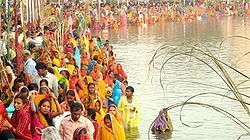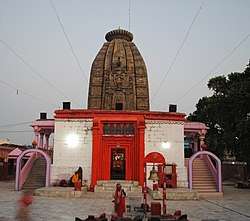Chhath
Chhath is an ancient Hindu Vedic festival historically native to the Indian subcontinent, more specifically, the Indian states of Bihar, Jharkhand[1] and Uttar Pradesh and the Madhesh region of Nepal.[2][3][4][5] The Chhath Puja is dedicated to the Sun and Shashthi devi (Chhathi Maiya) in order to thank them for bestowing the bounties of life on earth and to request the granting of certain wishes.[6] This festival is observed by Nepalese and Indian people along with their diaspora.[7]
| Chhath Puja | |
|---|---|
 Performing of prayer to Sun around the holy rivers, ponds and other small water bodies | |
| Also called | Chhaith Chhath Parva Chhath Puja Dala Chhath Dala Puja Surya Shashthi |
| Observed by |
|
| Liturgical Color | Colors related to Hinduism Saffron (or Bhagua) |
| Type | Cultural, Historical, Religious |
| Significance | To thank Sun for bestowing the bounties of life on earth and fulfilling particular wishes |
| 2019 date | 31 October to 3 November |
The festival does not involve idolatry and is dedicated to worship the Chhathi Maiya (Shashthi Mata) and sun God Surya alongwith his consorts Usha and Pratyusha the Vedic Goddess of Dawn and Dusk respectively. It is believed that the main sources of Sun's powers are his wife Usha and Pratyusha. In Chhath, there is a combined worship of both the powers along with the Sun. In the morning, worship of the first ray (Usha) of the Sun and the last ray (Pratyusha) of the Sun in the evening are offered to both of them. [8] And the rituals are rigorous and are observed over a period of four days.[9] They include holy bathing, fasting and abstaining from drinking water (Vratta), standing in water for long periods of time, and offering prasad (prayer offerings) and arghya to the setting and rising sun.[10] Some devotees also perform a prostration march as they head for the river banks.[11]
Environmentalists claim that Chhath is the most eco-friendly Hindu festival.[12][13] Although the festival is observed most elaborately in Madhesh (southern) region of Nepal and Indian states of Bihar, Jharkhand and UP, it is also more prevalent in areas where migrants from those areas have a presence. It is celebrated in all Northern regions and major Northern urban centers in India. The festival is celebrated in the regions including but not exclusive to the northeast region of India, Madhya Pradesh, Bihar, Uttarkhand, Uttar Pradesh, Chhattisgarh, Jharkhand, West Bengal, Rajasthan[14][15] Mumbai,[16] Mauritius, Fiji, South Africa, Trinidad and Tobago, Guyana, Suriname, Jamaica, other parts of the Caribbean, United States, United Kingdom, Republic of Ireland, Australia, New Zealand, Malaysia, Macau, Japan and Indonesia.
Types of Chhath Puja
- Chaitra Chhath - Celebrated in the Chaitra month of Vikram Samvat.
- Kartik Chhath - Celebrated in the Kartika month of Vikram Samvat. This one is most famous and celebrated at very large scale.
History

Chhath is a Vedic ritual dedicated to Hindu solar deity Surya, and goddess Shashthi (also called Chhathi Maiyya).[18] It has also been mentioned in both the major Indian epics - In Ramayana, when Rama and Sita returned Ayodhya, then people celebrated Deepawali, and on its sixth day Ramrajya was established. On this day Rama and Sita kept fast and Surya Shashthi/Chhath Puja was performed by Sita. Hence, she was blessed with Luv and Kush as their sons. While in the Mahabharata, Chhath Puja was performed by Draupadi/ Kunti after they escaped from Lakshagrih.
Rituals and traditions
The main worshipers, called parvaitin (from Sanskrit parv, meaning "occasion" or "festival"), are usually women. However, many men also observe this festival as Chhath is not a gender-specific festival.[19] The parvaitin pray for the well-being of their family, and for the prosperity of their offspring. In some communities, once a family member starts performing Chhath Puja, it is their compulsory duty to perform it every year and to pass it on to the following generations. The festival is skipped only if there happens to be a death in the family that year. If the person stops performing the ritual on any particular year, it stops permanently and one cannot resume it. In other communities, this is not mandatory.
Chhath Puja is a four day event. Entire house, its surrounding and pathways to the Ghaat is thoroughly cleaned. It starts with
- Kaddu Bhaat or Nahai Khai - The Parvaitin cooks the most Satvik Kaddu Bhaat (Bottle Gourd and Bengal Gram Lentil preparation with Arva Rice Bhaat) This preparation is served to the deity in the afternoon as Bhog. This initiates the parav and is the last meal of the Parvaitin during Chhath Puja
- Kharna - This is observed the next day of Kaddu Bhaat or on the eve of Pahli Arag (Arghya). The preparation starts in the afternoon. Parvaitin Cooks a Rice and Jaggery Kheer with Dosti Poori, other seasonal fruits and dry fruits as also offered to the deity as naivedya (bhoga)
- Pahli Arag
- Dusri Arag
The prasad offerings include sweets, Kheer, Thekua and fruits (mainly sugarcane, sweet lime and banana) offered in small bamboo soop winnows. The food is strictly vegetarian and is cooked without salt, onions or garlic. Emphasis is put on maintaining the purity of the food.[20]
Sandhya Arghya (evening offerings)
This day is spent preparing the prasad (offerings)at home. On the eve of this day, the entire household accompanies the Vratins to a riverbank, pond or a common large water body to make the offerings (Arghya) to the setting sun. It is during this phase of Chhath Puja that the devotees offer prayers to the just setting sun. The occasion is almost a carnival. Besides the Vratins, there are friends and family, and numerous participants and onlookers, all willing to help and receive the blessings of the worshipper. The folk songs sung on the evening of Chhath.
References
| Wikimedia Commons has media related to Chhath. |
- https://m.hindustantimes.com/cities/20k-perform-chhath-puja/story-ku0MAYpW55U9YBwBGE7ssK.html
- "Chhath festival celebrated in India and Nepal begins today : The Indian Express". Archived from the original on 5 November 2016.
- "Chhath natively celebrated in India and Nepal has significance in Hindu Culture". Archived from the original on 5 November 2016.
- Subhamoy Das. "Chhath Puja". About Religion. Archived from the original on 17 November 2015. Retrieved 16 November 2015.
- "Festivals of India And Nepal - Chhath Festival". Archived from the original on 7 June 2009.
- "A festival not confined to Bihar". Archived from the original on 23 December 2017.
- "No Nepalese and Bihari diasporas want to stay out of home in Chhath :: Patna Reportings". Archived from the original on 18 September 2014.
- https://www.teachingbanyan.com/essay/long-essay-on-chhath-puja/amp/
- "Chhath at the crossroads". Archived from the original on 6 November 2016.
- "Chhath rituals bring family together". Archived from the original on 24 October 2017.
- Sah, Jitendra (8 November 2016). "Sun worshippers". The Kathmandu Post. Archived from the original on 11 November 2016. Retrieved 11 November 2016.
Some devotees go to river banks to worship the sun by prostrating themselves the entire distance.
- "Chhath the most eco-friendly festival: Environmentalists". Archived from the original on 11 November 2016.
- "Ode to god of green things". Archived from the original on 1 August 2017.
- "Surat 1 lakh to celebrate chhath puja". Jai Bihar. 22 October 2009. Archived from the original on 3 January 2010. Retrieved 14 December 2009.
- "15 lakh to observe Chhath Puja in Delhi". Jai Bihar. 22 October 2009. Archived from the original on 2 November 2009. Retrieved 14 December 2009.
- "Juhu Beach decks up for worshiping the sun god". DNA India. 24 October 2009. Archived from the original on 28 February 2012. Retrieved 14 December 2009.
- https://www.india.com/travel/articles/chhath-puja-2017-famous-sun-temples-in-bihar-to-witness-chhath-puja-celebrations-3228015/
- Prateek Pathak. "Why do we celebrate Chhath Puja?". SpeakingTree. Retrieved 2 November 2019.
- "Men not far behind women in celebrating Chhath". Archived from the original on 11 November 2016.
- "'Rasiao-kheer', 'thekua' make for festive platter". The Times of India. 1 November 2011. Retrieved 13 March 2012.

